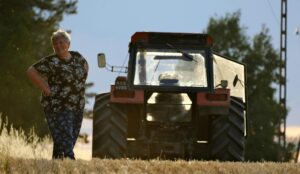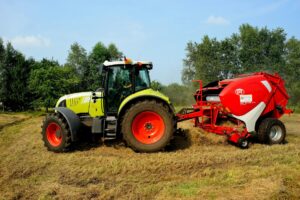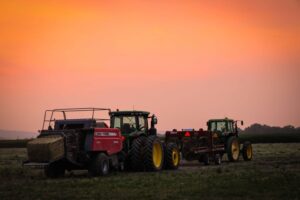Ford tractors have earned a legendary reputation for their durability, reliability, and ease of repair. Whether you own a classic Ford 8N, a compact Ford 3000, or a heavy-duty Ford TW Series, one thing remains essential—access to Ford tractor parts. From engine components to hydraulic systems, knowing which parts you need and where to find them can keep your tractor running for decades.
This comprehensive guide covers everything about Ford tractor parts, including types, buying tips, maintenance, compatibility with New Holland models, and where to source genuine and aftermarket components.
History of Ford Tractor Parts and Availability
Ford entered the agricultural machinery market in 1917 with the Fordson Model F, and over the decades, they produced millions of tractors. In 1991, Ford’s agricultural division merged with New Holland, and the Ford tractor name was phased out. However, Ford tractor parts remain widely available due to the massive number of units still in use.
Today, Ford tractor parts are manufactured by:
-
Original Equipment Manufacturers (OEMs) – Parts made to Ford’s original specifications.
-
Aftermarket suppliers – Companies producing compatible replacements at various price points.
-
Specialty restoration shops – Producing reproduction parts for vintage Ford tractors.
Types of Ford Tractor Parts
When maintaining or restoring your tractor, it helps to understand the main categories of Ford tractor parts.
1. Engine Parts
The engine is the heart of your tractor, and keeping it in top condition is crucial.
-
Pistons and piston rings
-
Cylinder heads and gaskets
-
Crankshafts and bearings
-
Camshafts
-
Oil filters and pumps
Tip: For older models like the Ford 8N or 3000, engine rebuild kits are available, containing all the necessary internal components.
2. Electrical Parts
Modern and vintage Ford tractors rely on electrical systems for ignition, lighting, and charging.
-
Starter motors
-
Alternators and generators
-
Voltage regulators
-
Ignition coils
-
Wiring harnesses
-
Light assemblies and switches
Maintenance Advice: Always check for corroded connectors or frayed wires before replacing entire electrical components.
3. Fuel System Parts
A well-maintained fuel system ensures smooth operation and efficiency.
-
Carburetors and carburetor kits
-
Fuel pumps
-
Fuel filters
-
Injectors (for diesel models)
-
Fuel tanks and caps
Note: Original-style carburetors are still produced for vintage Ford tractors, keeping restoration authentic.
4. Hydraulic System Parts
Ford tractors are famous for their strong and reliable hydraulic systems, especially models with the Ferguson 3-point hitch.
-
Hydraulic pumps
-
Hydraulic filters
-
Lift arms and linkage parts
-
Control valves
-
Seals and O-rings
Pro Tip: Using the correct hydraulic fluid type for your specific Ford tractor model prevents premature wear.
5. Transmission and Drivetrain Parts
The drivetrain transfers power from the engine to the wheels and implements.
-
Clutch kits
-
Transmission gears and bearings
-
Differential assemblies
-
Axles and seals
-
PTO (Power Take-Off) shafts and components
Common Replacement Need: PTO shaft seals on older Ford tractors often wear out after decades of use.
6. Cooling System Parts
Overheating is one of the fastest ways to damage a tractor engine.
-
Radiators
-
Water pumps
-
Thermostats
-
Cooling fans and belts
-
Hoses
Maintenance Tip: Flush the cooling system annually to prevent rust and mineral buildup.
7. Brake and Steering Parts
For safety and ease of operation, brake and steering systems must be maintained.
-
Brake shoes, pads, and discs
-
Master cylinders
-
Power steering pumps
-
Steering boxes and linkages
-
Tie rods and ends
8. Body and Cab Parts
Body parts not only improve appearance but also protect internal components.
-
Hoods, fenders, and grilles
-
Cab doors and windows
-
Seats and cushions
-
Floor mats and interior panels
-
Decals and badges
9. Tires and Wheels
-
Front and rear tractor tires
-
Inner tubes
-
Wheel rims
-
Lug bolts and nuts
Selection Tip: Match tire tread type (agricultural, industrial, or turf) to your usage for maximum performance.
How to Identify the Right Ford Tractor Parts
Finding the correct part is easier when you know your tractor’s details:
-
Model number – Found on the tractor chassis or operator’s manual.
-
Serial number – Indicates the year of manufacture.
-
Part number – Often stamped or labeled directly on the part.
-
Visual inspection – Match parts by shape, size, and mounting points.
Ford Tractor Parts Compatibility with New Holland
Since Ford’s merger with New Holland in 1991, many Ford tractor parts are interchangeable with New Holland models. For example:
-
Ford 4630 parts match New Holland 4630 models.
-
Ford TW Series shares components with some New Holland large-frame tractors.
This compatibility ensures that parts for even older Ford tractors remain accessible.
OEM vs. Aftermarket Ford Tractor Parts
When buying Ford tractor parts, you’ll often choose between OEM and aftermarket.
OEM (Original Equipment Manufacturer) Parts
-
Made to original Ford specifications
-
Typically more expensive
-
Guaranteed fit and quality
Aftermarket Parts
-
Made by third-party manufacturers
-
Usually more affordable
-
Quality varies by brand—choose reputable suppliers
Recommendation: For critical components like engine internals or hydraulic pumps, OEM or high-quality aftermarket parts are best.
Buying Ford Tractor Parts: Where to Shop
1. Authorized New Holland Dealers
-
Access to OEM Ford tractor parts
-
Professional advice on compatibility
-
Often more expensive
2. Online Tractor Parts Stores
-
Websites like TractorHouse, Yesterday’s Tractors, and Messick’s
-
Wide selection of vintage and modern parts
-
Convenient shipping options
3. Local Farm Supply Stores
-
Stock common maintenance items like filters and belts
-
Great for quick replacements
4. Tractor Salvage Yards
-
Affordable source for discontinued parts
-
Good for body panels, wheels, and rare components
5. Restoration Specialists
-
Ideal for classic Ford tractors
-
Can source reproduction decals, badges, and sheet metal
Tips for Maintaining Ford Tractor Parts
Regular maintenance extends the life of your tractor parts and reduces costly repairs.
-
Lubricate moving parts regularly to prevent wear.
-
Check fluid levels for engine oil, hydraulics, and coolant.
-
Inspect belts and hoses for cracks or wear.
-
Replace filters on schedule to protect the engine and hydraulics.
-
Store indoors to protect electrical and body parts from weather damage.
Commonly Replaced Ford Tractor Parts by Model
Ford 8N (1947–1952)
-
Carburetors
-
Brake shoes
-
Clutch kits
Ford 3000 (1965–1975)
-
Hydraulic pumps
-
PTO seals
-
Steering linkages
Ford 5000 Series
-
Engine overhaul kits
-
Water pumps
-
Alternators
Ford TW Series
-
Turbochargers
-
Transmission gears
-
Large-frame tires
Restoring Vintage Ford Tractors with Original Parts
For collectors and enthusiasts, restoring a Ford tractor with genuine parts increases both value and authenticity.
Restoration Steps:
-
Disassemble the tractor and inspect every part.
-
Replace worn mechanical parts with OEM or quality reproductions.
-
Sandblast and repaint using the correct Ford blue and gray colors.
-
Reinstall decals to original factory placement.
Troubleshooting and Replacing Ford Tractor Parts
Engine Won’t Start?
-
Check ignition coil, spark plugs, and fuel delivery.
Hydraulics Not Lifting?
-
Inspect hydraulic pump, control valves, and fluid levels.
PTO Not Engaging?
-
Check clutch adjustment, PTO shaft, and gear engagement.
Overheating?
-
Replace thermostat, flush radiator, and check water pump.
Frequently Asked Questions (FAQ) About Ford Tractor Parts
1. Are Ford tractor parts still being made? Yes. While Ford no longer produces tractors under its own name, many Ford tractor parts are still manufactured by New Holland (which took over Ford’s agricultural division in 1991) and aftermarket suppliers. This ensures that parts for both vintage and modern Ford tractors remain available.
2. Where can I buy Ford tractor parts? You can purchase Ford tractor parts from authorized New Holland dealerships, online parts retailers like Messick’s or Yesterday’s Tractors, local farm supply stores, and tractor salvage yards. For rare or vintage components, restoration specialists are an excellent option.
3. Are Ford tractor parts interchangeable with New Holland parts? In many cases, yes. After the Ford-New Holland merger, many models shared the same engineering and components. For example, parts from a Ford 4630 are often compatible with the New Holland 4630.
4. What’s the difference between OEM and aftermarket Ford tractor parts? OEM (Original Equipment Manufacturer) parts are built to Ford’s original specifications and guarantee a perfect fit. Aftermarket parts are produced by third-party manufacturers and can be more affordable, though quality varies by brand. For critical systems like the engine and hydraulics, OEM or high-quality aftermarket parts are recommended.
5. How do I find the right part for my Ford tractor? Identify your tractor’s model number, serial number, and year of manufacture. These details are usually on the chassis plate or in the owner’s manual. Matching these numbers ensures you get the correct part.
6. Are parts available for old Ford tractors like the 8N and 3000? Yes. The Ford 8N, 9N, 2N, 3000, and other classic models still have a strong aftermarket support network. You can find reproduction and used parts for everything from engine rebuild kits to original-style decals.
7. Can I restore a vintage Ford tractor using reproduction parts? Absolutely. Many restoration projects use reproduction parts that match the original design and specifications. This is common for components like sheet metal, badges, and seating.
8. What are the most commonly replaced Ford tractor parts? Some of the most commonly replaced parts include:
-
Filters (oil, fuel, hydraulic)
-
Clutch kits
-
PTO shaft seals
-
Hydraulic pumps
-
Carburetors
-
Electrical components like starters and alternators
9. Are Ford tractor parts expensive? Prices vary depending on whether you choose OEM or aftermarket parts, as well as the age and rarity of the model. Common maintenance items like filters and belts are inexpensive, while engine rebuild kits or hydraulic pumps can be more costly.
10. Can I install Ford tractor parts myself? Yes, many owners perform their own maintenance and repairs, especially on older models with simple mechanical systems. However, for major repairs such as engine overhauls or transmission work, professional assistance may be advisable.
Final Thoughts
Whether you’re performing routine maintenance, a complete restoration, or emergency repairs, Ford tractor parts are still widely available for models old and new. By understanding your tractor’s model, sourcing the correct parts, and maintaining them properly, you can ensure your Ford tractor continues to deliver decades of reliable service.
Ford’s legacy in agricultural machinery lives on, and with the right parts, your tractor can remain a dependable partner for farming, landscaping, or collecting.



